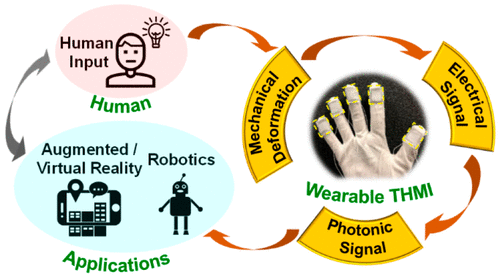Our official English website, www.x-mol.net, welcomes your feedback! (Note: you will need to create a separate account there.)
Wearable Triboelectric-Human-Machine Interface (THMI) Using Robust Nanophotonic Readout.
ACS Nano ( IF 17.1 ) Pub Date : 2020-06-23 , DOI: 10.1021/acsnano.0c03728 Bowei Dong 1, 2 , Yanqin Yang 1, 2 , Qiongfeng Shi 1, 2 , Siyu Xu 1, 2 , Zhongda Sun 1, 2 , Shiyang Zhu 3 , Zixuan Zhang 1, 2 , Dim-Lee Kwong 3 , Guangya Zhou 2, 4 , Kah-Wee Ang 1, 2 , Chengkuo Lee 1, 2, 5
ACS Nano ( IF 17.1 ) Pub Date : 2020-06-23 , DOI: 10.1021/acsnano.0c03728 Bowei Dong 1, 2 , Yanqin Yang 1, 2 , Qiongfeng Shi 1, 2 , Siyu Xu 1, 2 , Zhongda Sun 1, 2 , Shiyang Zhu 3 , Zixuan Zhang 1, 2 , Dim-Lee Kwong 3 , Guangya Zhou 2, 4 , Kah-Wee Ang 1, 2 , Chengkuo Lee 1, 2, 5
Affiliation

|
With the rapid advances in wearable electronics and photonics, self-sustainable wearable systems are desired to increase service life and reduce maintenance frequency. Triboelectric technology stands out as a promising versatile technology due to its flexibility, self-sustainability, broad material availability, low cost, and good scalability. Various triboelectric–human–machine interfaces (THMIs) have been developed including interactive gloves, eye blinking/body motion-triggered interfaces, voice/breath monitors, and self-induced wireless interfaces. Nonetheless, THMIs conventionally use electrical readout and produce pulse-like signals due to the transient charge flows, leading to unstable and lossy transfer of interaction information. To address this issue, we propose a strategy by equipping THMIs with robust nanophotonic aluminum nitride (AlN) modulators for readout. The electrically capacitive nature of AlN modulators enables THMIs to work in the open-circuit condition with negligible charge flows. Meanwhile, the interaction information is transduced from THMIs’ voltage to AlN modulators’ optical output via the electro-optic Pockels effect. Thanks to the negligible charge flow and the high-speed optical information carrier, stable, information-lossless, and real-time THMIs are achieved. Leveraging the design flexibility of THMIs and nanophotonic readout circuits, various linear sensitivities independent of force speeds are achieved in different interaction force ranges. Toward practical applications, we develop a smart glove to realize continuous real-time robotics control and virtual/augmented reality interaction. Our work demonstrates a generic approach for developing self-sustainable HMIs with stable, information-lossless, and real-time features for wearable systems.
中文翻译:

使用坚固的纳米光子读数的可穿戴摩擦电人机界面(THMI)。
随着可穿戴电子设备和光子学的飞速发展,人们希望能够自我维持的可穿戴系统延长使用寿命并减少维护频率。摩擦电技术因其灵活性,自我可持续性,广泛的材料可用性,低成本和良好的可扩展性而成为一种有前途的多功能技术。已经开发了各种摩擦式人机界面(THMI),包括交互式手套,眨眼/人体动作触发界面,语音/呼吸监测器以及自感应无线界面。尽管如此,由于瞬态电荷流,THMI通常使用电读出并产生类似脉冲的信号,从而导致交互信息的不稳定和有损传递。为了解决这个问题,我们通过为THMI配备坚固的纳米光子氮化铝(AlN)调制器来提出一种读取策略。AlN调制器的电容性质使THMI可以在开路条件下以可忽略的电荷流工作。同时,交互信息从THMI的电压转换为AlN调制器的光输出通过电光普克尔斯效应。借助微不足道的电荷流和高速光学信息载体,可以实现稳定,无信息丢失和实时的THMI。利用THMI和纳米光子读出电路的设计灵活性,可以在不同的相互作用力范围内实现与力速度无关的各种线性灵敏度。针对实际应用,我们开发了一款智能手套,可实现连续的实时机器人控制和虚拟/增强现实交互。我们的工作演示了一种通用方法,该方法可以为可穿戴系统开发具有稳定,无信息丢失和实时功能的自持式HMI。
更新日期:2020-07-28
中文翻译:

使用坚固的纳米光子读数的可穿戴摩擦电人机界面(THMI)。
随着可穿戴电子设备和光子学的飞速发展,人们希望能够自我维持的可穿戴系统延长使用寿命并减少维护频率。摩擦电技术因其灵活性,自我可持续性,广泛的材料可用性,低成本和良好的可扩展性而成为一种有前途的多功能技术。已经开发了各种摩擦式人机界面(THMI),包括交互式手套,眨眼/人体动作触发界面,语音/呼吸监测器以及自感应无线界面。尽管如此,由于瞬态电荷流,THMI通常使用电读出并产生类似脉冲的信号,从而导致交互信息的不稳定和有损传递。为了解决这个问题,我们通过为THMI配备坚固的纳米光子氮化铝(AlN)调制器来提出一种读取策略。AlN调制器的电容性质使THMI可以在开路条件下以可忽略的电荷流工作。同时,交互信息从THMI的电压转换为AlN调制器的光输出通过电光普克尔斯效应。借助微不足道的电荷流和高速光学信息载体,可以实现稳定,无信息丢失和实时的THMI。利用THMI和纳米光子读出电路的设计灵活性,可以在不同的相互作用力范围内实现与力速度无关的各种线性灵敏度。针对实际应用,我们开发了一款智能手套,可实现连续的实时机器人控制和虚拟/增强现实交互。我们的工作演示了一种通用方法,该方法可以为可穿戴系统开发具有稳定,无信息丢失和实时功能的自持式HMI。


























 京公网安备 11010802027423号
京公网安备 11010802027423号